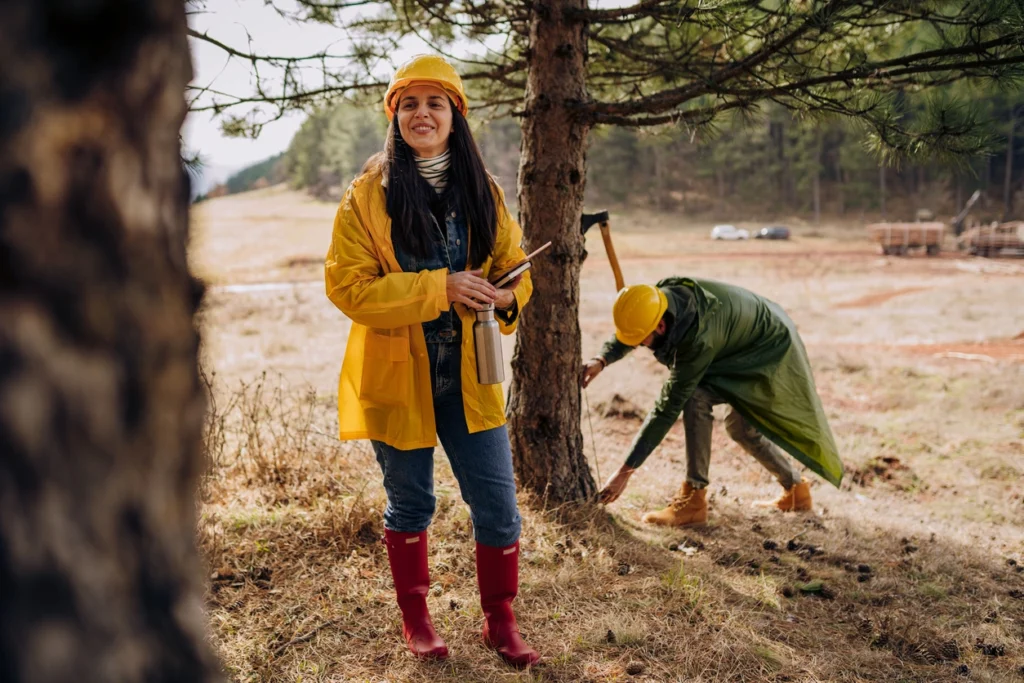Imagine a detective piecing together clues at a crime scene. Biosurveys are similar – they involve scientists carefully examining plants, animals, and the overall condition of an environment. But instead of solving crimes, biosurveys aim to understand the health of our planet. They provide vital information about pollution levels, the presence of endangered species, and how ecosystems are changing.
By understanding biosurveys, you gain a powerful tool for protecting our environment. Their results inform critical decisions about conservation efforts, pinpoint areas affected by pollution, and guide policies to ensure a healthier future for everyone.

Types of Biosurveys
The world of biosurveys is vast, spanning habitats both on land and in water. Here’s a closer look at some of the specializations:
Terrestrial Biosurveys
These delve into forests, grasslands, deserts, and other land-based ecosystems. Scientists might focus on identifying and mapping diverse plant communities, tracking populations of birds, mammals, or insects, or carefully examining lichens and fungi that contribute to ecosystem health. Techniques can range from visual observations and plot sampling to camera traps and audio recordings.
Aquatic Biosurveys
These focus on the watery realms of our planet, exploring freshwater lakes, rivers, and streams, as well as marine environments like coral reefs and the open ocean. Researchers might study fish populations to assess ecosystem health, examine water quality through chemical and biological indicators, or investigate the intricate ecosystems built upon coral reefs.
Other Specializations
Biosurveys extend far beyond these well-known types. They can investigate the hidden world of microbes in the soil, helping us understand everything from agricultural potential to the impacts of pollution. Aerial or satellite surveys might map changes in land cover over time, providing crucial information for conservation planning.
Here’s a list of other fields of specializations:
Soil Surveys: These analyze the physical, chemical, and biological properties of soil. They play a crucial role in understanding soil health, agricultural potential, and how the soil influences the overall ecosystem.
- Microbial Surveys: These explore the diverse world of microscopic organisms like bacteria, archaea, and viruses. They offer insights into areas ranging from human health to nutrient cycling in the environment.
- Paleontological Surveys: These focus on uncovering and studying fossils. They help us understand the history of life on Earth and how ancient ecosystems have changed over time.
- Atmospheric Surveys: These examine the composition and characteristics of the atmosphere. Researchers might track pollutants, measure greenhouse gasses, or analyze how the atmosphere interacts with land and water ecosystems.
- Socio-ecological Surveys: These combine biological and social data to understand how humans interact with and impact the environment. They are beneficial when managing resources, developing sustainable practices, and addressing social-environmental conflicts.

Designing a Biosurvey
Before heading into the field or laboratory, designing a successful biosurvey requires careful planning. Consider these essential components:
Clear Objectives
Start by defining what you want to learn. Are you assessing the overall health of a forest? Monitoring pollution levels in a stream? Pinpointing the presence of an endangered species? Your objectives will guide all your following decisions.
Sampling Design
How you collect data is crucial. Will you use random sampling for a broad overview, or is stratified sampling necessary to account for environmental variations? Understanding different sampling methods is key to getting accurate results.
Choosing the Right Methodology
Techniques vary widely depending on your goals. You might use quadrats for studying plant communities, collect water samples to test for chemical pollutants, or set up camera traps for monitoring elusive animals. Selecting appropriate methods is essential.
Establishing Quality Control
Ensure your results are reliable. This includes calibrating equipment, documenting procedures, and possibly collecting replicate samples to double-check your findings.
Example: A Simple Biosurvey
Let’s imagine you want to assess the plant diversity in a local park. Here’s a basic design process:
- Objective: Document the types and abundance of plants within the park.
- Sampling Design: Use a systematic approach, establishing evenly spaced transects (lines) through various park habitats.
- Methodology: Along each transect, use quadrats (small plots) to identify and count plants. Use field guides or online resources for unknown species.
- Quality control: Take clear photos of unidentified plants for later verification, and perhaps have a fellow botanist double-check your work.

Common Biosurvey Techniques
Quadrat Sampling
- Purpose: Used to examine a specific area, often for plant diversity or small animal abundance.
- Steps:
- Construct a quadrat (a square frame of a fixed size).
- Randomly place the quadrat in your study area.
- Identify and count the organisms present within the quadrat.
- Repeat multiple times in different locations for better representation.
- Image suggestion: A researcher placing a quadrat on the ground, filled with various plants.
Transect Sampling
- Purpose: Study changes across a gradient (e.g., from a forest edge to its interior).
- Steps:
- Establish a transect line through the study area.
- At intervals along the line, collect data using quadrats or simply note observations.
- Analyze the data to see how species distribution or abundance changes.
- Image suggestion: A tape measure stretched as a transect through a habitat, with quadrats marked alongside.
Water Quality Testing (Basic Parameters)
- Purpose: Assess water health by measuring key indicators.
- Steps:
- Collect a water sample using appropriate containers and techniques.
- Test for pH (acidity/alkalinity) using a pH meter or test strips.
- Measure dissolved oxygen using a meter or a field test kit.
- Assess turbidity (cloudiness) using a turbidity tube or a specialized meter.
- Image suggestion: Close-up of test kits used for these parameters, or a researcher dipping a water sampling bottle into a stream.
Macroinvertebrate Collection (Aquatic)
- Purpose: These organisms are excellent pollution indicators for water quality.
- Steps:
- Select a sampling site in flowing water, like a stream.
- Use a kick net, positioned downstream, to disturb the streambed.
- Current carries dislodged macroinvertebrates into your net.
- Rinse the contents of the net into a tray with water for sorting and identification.
- Image suggestion: Demonstrate a kick-net held downstream, and a sorting tray with various macroinvertebrate specimens.
Important Reminder: Safety and permissions come first! Always wear appropriate gear, understand local regulations, and minimize disruption to the environment.
Data Analysis and Interpretation
After collecting your biosurvey data, it’s time to uncover the insights it holds. Here’s a simplified look at the process:
- Calculating Indices: Biological indices are numerical tools that help summarize complex information. For example, a diversity index can measure how many different species are present in an area, and their relative abundance. Calculating these indices usually involves simple formulas that you can find in field guides or online resources.
- Statistical Analysis: Going beyond basic calculations, statistics can help answer questions about your biosurvey results. Even if your audience is beginners, don’t be afraid to introduce concepts like:
- Comparing different sites or sampling periods to see if there are significant differences.
- Testing if there is a correlation between environmental factors and species presence.
- Interpretation and Presentation: Your goal is to transform data into knowledge. Consider these points:
- What patterns do you see? What stories do the numbers and statistics tell?
- Link your findings back to your initial objectives.
- Use visualizations! Graphs, charts, and maps can make your results easier to understand for everyone.
Example: Analyzing Bird Survey Data
Imagine you’ve tracked bird populations over time. Perhaps you’ve calculated a diversity index to see how species variety has changed. Statistical analysis might then show if this change is significantly different from past years, indicating a potential positive or negative trend. You could present these findings using graphs and accompany them with explanations connecting any changes you see to possible causes (e.g., habitat loss, conservation efforts).
The Role of Technology in Biosurveys
Technology is transforming the way we conduct biosurveys, making them more efficient, accurate, and accessible. Here’s an overview of its impact:
Data Collection Tools:
- GPS: Precise location data lets researchers pinpoint sampling sites, track animal movements, and map changes in land cover over time.
- Environmental Sensors: Specialized sensors can measure everything from water temperature and air quality to soil moisture and light levels.
- Data Logging Software: Apps and software streamline data collection in the field, reducing errors and making information easily transferable for analysis.
Data Analysis Software:
- GIS Mapping: Geographic Information Systems (GIS) let researchers visualize data spatially, uncover patterns, and create detailed maps highlighting biodiversity hotspots or areas of environmental concern.
- Statistical Programs: Powerful software helps with advanced analysis, including complex calculations, statistical tests, and generating informative graphs and charts.
Citizen Science:
- Apps and Platforms: Tools like iNaturalist allow anyone with a smartphone to record observations of plants, animals, and contribute to large-scale biosurvey projects.
- Public Participation: Citizen science democratizes data collection, expands the reach of biosurveys, and raises environmental awareness across communities.
Technology empowers researchers and even non-scientists to make valuable contributions to our understanding of the environment. It’s an exciting tool in the ongoing effort to protect our planet.
From Exploration to Action: Biosurveys Inform Decision-Making
Biosurveys are more than just scientific investigations. They provide a powerful lens through which we can understand the intricate workings of our ecosystems and the impact we have on them. Whether it’s tracking birds in a local park, studying fish populations in a river, or examining microbes in the soil, biosurveys provide reliable data – information that is essential for making informed decisions.
This knowledge empowers us to protect endangered habitats, pinpoint sources of pollution, and devise strategies for a more sustainable future. From conservationists and scientists to policymakers and concerned citizens, biosurveys serve as a call to action, urging us to use this understanding to safeguard the health of our planet for generations to come.
Frequently Asked Questions About Basics of Biosurveys
Can I participate in biosurveys as a volunteer?
Absolutely! Citizen science projects focused on biosurveys are increasingly common. Platforms like iNaturalist make it easy to record your observations and contribute to a massive database used by researchers. Look for local conservation organizations, parks, or universities that may have volunteer biosurvey programs.
What are the ethical considerations in conducting biosurveys?
Biosurveys must prioritize minimizing their impact on the environment. This includes obtaining necessary permits, reducing disturbance to wildlife and habitats, and following ethical sampling practices. Researchers must also consider the potential impact of data release, ensuring it doesn’t increase vulnerability for endangered species to poaching or habitat destruction.
How do I get started with a basic biosurvey in my community?
Start by defining a simple objective and choosing a suitable location (like a park or forest). Research common survey methods used for your target organisms (e.g., plants, birds, insects). Many online guides and field manuals can aid in this process. Remember, even simple observations and species counts can be valuable contributions to understanding your local ecosystem.
How are biosurveys used to address climate change?
Biosurveys play a crucial role in monitoring the effects of climate change on ecosystems. Long-term surveys help track changes in species distribution, migration patterns, and the health of temperature-sensitive ecosystems like coral reefs. This data informs climate change models and guides adaptation and mitigation strategies.
Are there biosurvey careers outside of traditional research?
Yes! Biosurvey skills are in demand in various fields. Environmental consulting companies use them to assess the impact of development projects. Government agencies employ biosurvey specialists for conservation and monitoring programs. Even educators with biosurvey experience can bring hands-on science to classrooms and nature centers.